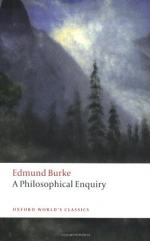
|
| Name: _________________________ | Period: ___________________ |
This test consists of 5 short answer questions, 10 short essay questions, and 1 (of 3) essay topics.
Short Answer Questions
1. Which medium does Burke feel arouses the passions most effectively?
2. According to Burke, what is more powerful than light at representing the sublime?
3. What examples does Burke use to argue that some sights are pleasurable to all people?
4. How do all emotions and passions affect the human mind?
5. What does Burke use as a common, but bad, example of infinity?
Short Essay Questions
1. Describe the main difference between light and dark relative to the sublime.
2. What kind of infinity exists in "pleasing objects," according to Burke, and what is an example he uses to support his claim?
3. According to Burke, why can grief be considered pleasurable?
4. What is the cause of a wrong taste, and what are examples of it?
5. What is the main problem with creating prescribed definitions, especially of taste, according to Burke?
6. What does Burke identify as the central tension between the imagination and the judgment?
7. What motivated Burke to write "A Philosophical Enquiry Into the Origin of Our Ideas of the Sublime and Beautiful"?
8. What is "magnificence," according to Burke?
9. What causes Burke to offer a second edition of "A Philosophical Enquiry Into the Origin of Our Ideas of the Sublime and Beautiful"?
10. Describe Burke's idea of beauty.
Essay Topics
Write an essay for ONE of the following topics:
Essay Topic 1
Describe Burke's definition of the sublime. What passions or sensations fuel it? What is the significance of pain and pleasure to the sublime? Describe Burke's ideas of the passions belonging to self-preservation and the passions belonging to society. What are the key differences between them? Give at least three examples of things which would be considered sublime, and explain the relevance of these examples.
Essay Topic 2
What, according to Burke, is sublime about religion? What tool do many religions make use of, to what ends? Carefully analyze the example Burke offers in Part II, Section V, beginning on page 61. Pay close attention to Burke's word choice, use of imagery, figurative language, selection of references or allusions, and the general tone with which he writes. How does this example reinforce Burke's assertions about religion and power? Are there any problems you see with this example, or any counter-arguments you can mak?
Essay Topic 3
Select three examples from anywhere in the text of what you would consider scientific methodology in Burke's writing. These may be specific examples he cites (such as his personal anecdotes or the selections from literature he reads), the structure or progression of his subjects or thought process in a section on a specific topic, or his tone as he considers the nature of things beautiful or sublime. Consider how Burke's methodology is, in itself, rather scientific in nature. For each example you selected, write a synopsis of why the selection seems scientific in nature to you. To be "scientific" in nature is, for example, to test one's theories somehow, to consider other theories in relation to one's own, to give evidence that supports one's theories, to maintain a tone of professional, instead of personal, interest, and so on.
|
This section contains 986 words (approx. 4 pages at 300 words per page) |

|




